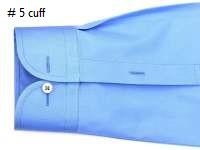Want to buy or sell something? Check the classifieds
-
The Fedora Lounge is supported in part by commission earning affiliate links sitewide. Please support us by using them. You may learn more here.
You are using an out of date browser. It may not display this or other websites correctly.
You should upgrade or use an alternative browser.
You should upgrade or use an alternative browser.
French cuff question
- Thread starter carldelo
- Start date
Papperskatt
Practically Family
- Messages
- 506
- Location
- Sweden
Here's a pic of Jude Law wearing a french cuff "barrel cuff style" in Sherlock Holmes. I think it looks great!


Featured products
-
 Gustin Vintage Heavyweight Sweatshirt - Natural Rainbow Nep - $119 Rugged 14oz cotton that gets better with every wear.
Gustin Vintage Heavyweight Sweatshirt - Natural Rainbow Nep - $119 Rugged 14oz cotton that gets better with every wear. -
 Grant Stone Diesel Boot Dark Olive Chromexcel - #395 Goodyear welted, Horween Chromexcel, classic good looks.
Grant Stone Diesel Boot Dark Olive Chromexcel - #395 Goodyear welted, Horween Chromexcel, classic good looks. -
 Himel Bros. - The Ross Mk. 1 Leather Jacket Classic D-pocket motorcycle/aviator style jacket.
Himel Bros. - The Ross Mk. 1 Leather Jacket Classic D-pocket motorcycle/aviator style jacket.
carldelo
One Too Many
- Messages
- 1,568
- Location
- Astoria, NYC
Ah interesting, thanks very much for this picture, I feel moderately vindicated.
This points up an issue I've found. You see how the overlap is done - it's reversed compared to a standard button cuff, i.e. the underside of the cuff is on top.
When nesting a French cuff as A.J. suggested, this is the natural way that the cuffs lay --- the underside has to be on top in order to have the fabric arranged properly for the secondary button. It looks kind of strange at first, but makes sense when you see it in detail.
This points up an issue I've found. You see how the overlap is done - it's reversed compared to a standard button cuff, i.e. the underside of the cuff is on top.
When nesting a French cuff as A.J. suggested, this is the natural way that the cuffs lay --- the underside has to be on top in order to have the fabric arranged properly for the secondary button. It looks kind of strange at first, but makes sense when you see it in detail.
Ernest P Shackleton
One Too Many
- Messages
- 1,243
- Location
- Midwest
When I opened this thread, I thought the discussion was going to be about tight rolling (pinch rolling) your pant cuffs because I've, at times, heard tight rolling also referred to as French cuffs.
I've only heard of the 'French Cuff' applied in two instances:1.) Shirt cuffs as we are discussing here. And 2.) A tailoring term (also called a faux cuff) for a technique used to create a cuff on trousers when there is limited material available.
Papperskatt
Practically Family
- Messages
- 506
- Location
- Sweden
Quetzal
One of the Regulars
- Messages
- 147
- Location
- United States
My first vintage pieces were three sets of cuff links (circa 1950s-1960s) that were purchased for pennies. Since then, I've always worn cuff links with suits, but never anything more casual, in part because it just seems right and help others differentiate between "casual" and "dressed-up". I'll always wear them, regardless if others hate their "clunky" and "outdated" appearance.
-Quetzal
-Quetzal
Talbot
One Too Many
- Messages
- 1,855
- Location
- Melbourne Australia
I saw this pic of Nikola Tesla and it got me thinking about this old thread. It looks like he's wearing a french cuff barrel cuff style.
View attachment 14451
Towards the end of 'Gone with the Wind' Clark Gable also wears links in this manner. I can not say if they are French Cuffs or not tho', and frankly...
Similar threads
- Replies
- 15
- Views
- 1K
- Replies
- 4
- Views
- 1K

